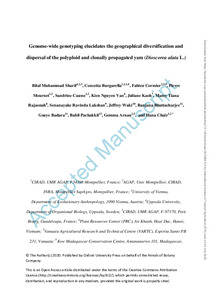| dc.contributor.author | Sharif, B.M. |
| dc.contributor.author | Burgarella, C. |
| dc.contributor.author | Cormier, F. |
| dc.contributor.author | Mournet, P. |
| dc.contributor.author | Causse, S. |
| dc.contributor.author | Van, K.N. |
| dc.contributor.author | Kaoh, J. |
| dc.contributor.author | Rajaonah, M.T. |
| dc.contributor.author | Lakshan, S.R. |
| dc.contributor.author | Waki, J. |
| dc.contributor.author | Bhattacharjee, R. |
| dc.contributor.author | Gueye, B. |
| dc.contributor.author | Pachakkil, B. |
| dc.contributor.author | Arnau, G. |
| dc.contributor.author | Chaïr, H. |
| dc.date.accessioned | 2022-01-11T11:36:53Z |
| dc.date.available | 2022-01-11T11:36:53Z |
| dc.date.issued | 2020-11-02 |
| dc.identifier.citation | Sharif, B.M., Burgarella, C., Cormier, F., Mournet, P., Causse, S., Van, K.N., ... & Chair, H. (2020). Genome-wide genotyping elucidates the geographical diversification and dispersal of the polyploid and clonally propagated yam (Dioscorea alata L.). Annals of Botany, 126(6), 1029-1038. |
| dc.identifier.issn | 0305-7364 |
| dc.identifier.uri | https://hdl.handle.net/20.500.12478/7307 |
| dc.description.abstract | Background and Aims Inferring the diffusion history of many human-dispersed species is still not straightforward due to unresolved past human migrations. The centre of diversification and routes of migration of the autopolyploid and clonally propagated greater yam, Dioscorea alata, one of the oldest edible tubers, remain unclear. Here, we address yam demographic and dispersal history using a worldwide sample. Methods We characterized genome-wide patterns of genetic variation using genotyping by sequencing 643 greater yam accessions spanning four continents. First, we disentangled the polyploid and clonal components of yam diversity using allele frequency distribution and identity by descent approaches. We then addressed yam geographical origin and diffusion history with a model-based coalescent inferential approach. Key Results Diploid genotypes were more frequent than triploids and tetraploids worldwide. Genetic diversity was generally low and clonality appeared to be a main factor of diversification. The most likely evolutionary scenario supported an early divergence of mainland Southeast Asian and Pacific gene pools with continuous migration between them. The genetic make-up of triploids and tetraploids suggests that they have originated from these two regions before westward yam migration. The Indian Peninsula gene pool gave origin to the African gene pool, which was later introduced to the Caribbean region. Conclusions Our results are congruent with the hypothesis of independent domestication origins of the two main Asian and Pacific gene pools. The low genetic diversity and high clonality observed suggest a strong domestication bottleneck followed by thousands of years of widespread vegetative propagation and polyploidization. Both processes reduced the extent of diversity available for breeding, and this is likely to threaten future adaptation. |
| dc.description.sponsorship | CGIAR Research Program on Roots, Tubers and Bananas |
| dc.description.sponsorship | Agropolis Foundation |
| dc.format.extent | 1029-1038 |
| dc.language.iso | en |
| dc.subject | Propagation |
| dc.subject | Demography |
| dc.subject | Geographical Distribution |
| dc.subject | Polyploidy |
| dc.subject | Genomics |
| dc.subject | Yams |
| dc.subject | Dioscorea Alata |
| dc.title | Genome-wide genotyping elucidates the geographical diversification and dispersal of the polyploid and clonally propagated yam (Dioscorea alata L.) |
| dc.type | Journal Article |
| cg.contributor.crp | Genebanks |
| cg.contributor.crp | Roots, Tubers and Bananas |
| cg.contributor.affiliation | University of Vienna |
| cg.contributor.affiliation | Université de Montpellier |
| cg.contributor.affiliation | Plant Resources Center, Vietnam |
| cg.contributor.affiliation | Vanuatu Agricultural Research and Technical Centre |
| cg.contributor.affiliation | Kew Madagascar Conservation Centre |
| cg.contributor.affiliation | Field Crops Research and Development Institute, Sri Lanka |
| cg.contributor.affiliation | National Agricultural Research Institute, Papua New Guinea |
| cg.contributor.affiliation | International Institute of Tropical Agriculture |
| cg.contributor.affiliation | Tokyo University of Agriculture |
| cg.coverage.region | Africa |
| cg.coverage.region | Asia |
| cg.coverage.region | Caribbean |
| cg.coverage.country | Benin (Dahomey) |
| cg.coverage.country | Burkina Faso (Upper Volta) |
| cg.coverage.country | Cote d’Ivoire (Ivory Coast) |
| cg.coverage.country | Cuba |
| cg.coverage.country | Dominican Republic |
| cg.coverage.country | Equatorial Guinea |
| cg.coverage.country | Ghana |
| cg.coverage.country | Haiti |
| cg.coverage.country | India |
| cg.coverage.country | Jamaica |
| cg.coverage.country | Japan |
| cg.coverage.country | Madagascar |
| cg.coverage.country | Nigeria |
| cg.coverage.country | Papua New Guinea |
| cg.coverage.country | Republic of the Congo |
| cg.coverage.country | Saint Lucia |
| cg.coverage.country | Saint Vincent and the Grenadines |
| cg.coverage.country | Sierra Leone |
| cg.coverage.country | Sri Lanka |
| cg.coverage.country | Togo |
| cg.coverage.country | Vanuatu |
| cg.coverage.country | Vietnam |
| cg.coverage.hub | Headquarters and Western Africa Hub |
| cg.researchtheme | Biotech and Plant Breeding |
| cg.identifier.bibtexciteid | SHARIF:2020 |
| cg.isijournal | ISI Journal |
| cg.authorship.types | CGIAR and developing country institute |
| cg.iitasubject | Agronomy |
| cg.iitasubject | Bioscience |
| cg.iitasubject | Genetic Improvement |
| cg.iitasubject | Plant Breeding |
| cg.iitasubject | Plant Production |
| cg.iitasubject | Yam |
| cg.journal | Annals of Botany |
| cg.notes | Open Access Article; Published online: 27 Jun 2020 |
| cg.accessibilitystatus | Open Access |
| cg.reviewstatus | Peer Review |
| cg.usagerightslicense | Creative Commons Attribution 4.0 (CC BY 0.0) |
| cg.targetaudience | Scientists |
| cg.identifier.doi | https://dx.doi.org/10.1093/aob/mcaa122 |
| cg.iitaauthor.identifier | Ranjana Bhattacharjee: 0000-0002-5184-5930 |
| cg.iitaauthor.identifier | Badara GUEYE: 0000-0003-3157-8772 |
| cg.futureupdate.required | No |
| cg.identifier.volume | 126 |

